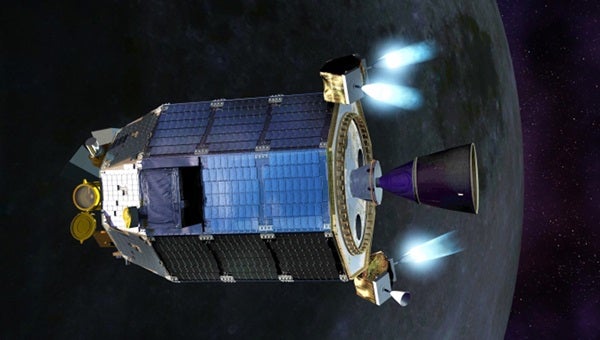On November 20, the spacecraft successfully entered its planned orbit around the Moon’s equator — a unique position that allows the small probe to make frequent passes from lunar day to lunar night. This will provide a full scope of the changes and processes occurring within the Moon’s tenuous atmosphere.
LADEE now orbits the Moon about every two hours at an altitude of 8 to 37 miles (12 to 60 kilometers) above the Moon’s surface. For about 100 days, the spacecraft will gather detailed information about the structure and composition of the thin lunar atmosphere and determine whether dust is being lofted into the lunar sky.
“A thorough understanding of the characteristics of our lunar neighbor will help researchers understand other small bodies in the solar system, such as asteroids, Mercury, and the moons of outer planets,” said Sarah Noble from NASA Headquarters in Washington, D.C.
Scientists also will be able to study the conditions in the atmosphere during lunar sunrise and sunset, where previous crewed and robotic missions detected a mysterious glow of rays and streamers reaching high into the lunar sky.
On November 20, flight controllers in the LADEE Mission Operations Center at NASA’s Ames Research Center in Moffett Field, California, confirmed LADEE performed a crucial burn of its orbit control system to lower the spacecraft into its optimal position to enable science collection. Mission managers will continuously monitor the spacecraft’s altitude and make adjustments as necessary.
“Due to the lumpiness of the Moon’s gravitational field, LADEE’s orbit requires significant maintenance activity with maneuvers taking place as often as every three to five days, or as infrequently as once every two weeks,” said Butler Hine from Ames. “LADEE will perform regular orbital maintenance maneuvers to keep the spacecraft’s altitude within a safe range above the surface that maximizes the science return.”
In addition to science instruments, the spacecraft carried the Lunar Laser Communications Demonstration, NASA’s first high-data-rate laser communication system. It is designed to enable satellite communication at rates similar to those of high-speed fiber optic networks on Earth. The system was tested successfully during the commissioning phase of the mission, while LADEE was still at a higher altitude.










